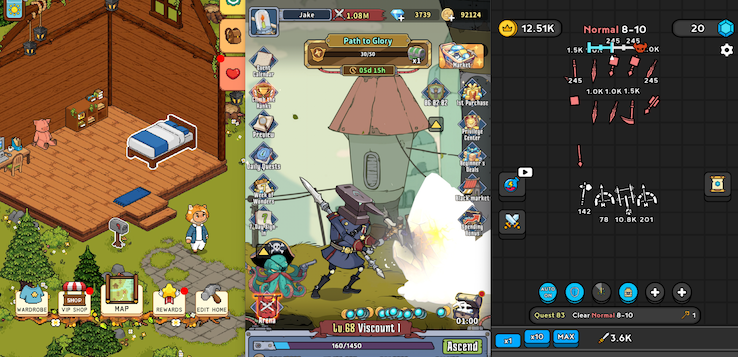
3 fun little Android games: 💸 Forest Fables, 💡 Dig-Dig Rush, 📃 Paper War
A decent mixture of games this month, from the scarily complex to the far-too-simple! Plus, the first ever educational game I’d recommend to everyone.
#1: Forest Fables
Forest Fables is the most genuinely enjoyable “educational” game I have ever played. It is clearly a cosy game trying to give players a fun experience, yet sneaks in some education, and I can’t stop playing it!
Screenshots
All screenshots are from version 1.4.2:
| Map | Quest | Volcano |
|---|---|---|
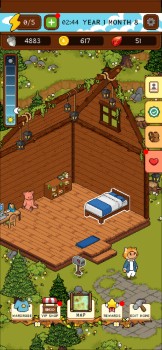 |
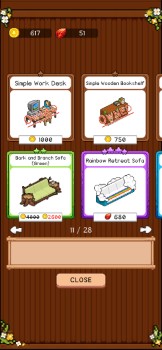 |
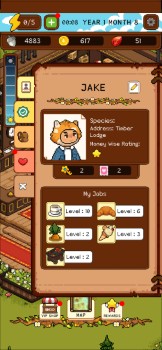 |
| My home | Shopping | Profile |
|---|---|---|
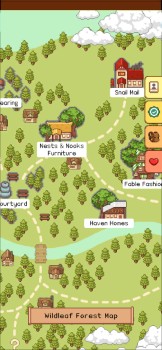 |
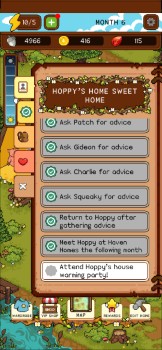 |
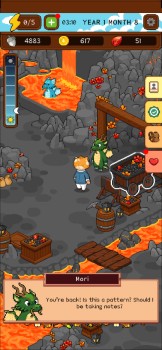 |
Review
I’m generally not interested in “cozy” games, or “life sim” games, and this is both. However, the combination of a simple gameplay loop, beautiful artwork, and an extremely fair and a non-manipulative economy culminates in what can only be described as “a nice time”. I love it.
The general story is you’ve been kidnapped and taken to “Wildleaf Forest”, where you’ll spend your days wandering around locations, talking to the inhabitants, completing quests, and earning & spending money. At no point is it particularly challenging, with quests typically involving solving simple riddles, navigating conversation trees, or completing “spot the object” games in areas. These are all unique, intuitive, tracked in your quest log, and offer generous rewards.
However, this plain description doesn’t do the game justice. The writing is excellent, with each character expressing their unique personality in simple conversations, and each feeling like a “real” character. Similarly, the artwork is easily amongst the best I’ve ever seen, with the slightly abstracted pixel art being by favourite style.
Movement in an area is only possibly by tapping on actionable items, such as NPCs, minigames (more on that next!), or quest objects. This avoids any pointless wandering around, since you’ll only move when you’ve done something useful. The movement and style strongly reminds me of Habbo Hotel, a game I played ~18 years ago, so nostalgia is definitely impacting my experience! Unlike Habbo Hotel, Forest Fables is single-player and will be a relatively short experience (likely a few days unless you get into the furniture / clothing), but that’s OK!
The minigames are unlocked via keys, and none will be anything new, just solid implementations of basic minigames. Things like “tap the button at the right time to cook the croissant”, or “pour the coffee ingredients without overflowing”, or “pick the carrots but not the turnips”. Simple games, that are short and rewarding enough to not be a chore. There is a day/night cycle, with some minigames only being accessible earlier in the day, but this doesn’t affect gameplay too much.
Your motivation day-to-day is, broadly-speaking, earning and spending currencies. Whilst there does seem to be too many, it’s important to highlight how absolutely optional almost all of them are, with the primary use being entirely cosmetic furniture, clothing, or houses. Whilst some currency is required for repairing your house, or completing quests, this is a negligible amount compared to the purely aesthetic items. So, how do you earn currencies?
The currencies are:
- Energy: Whilst this earned is 1 per 10m, it’s not like normal energy! It only controls how many minigames you can play per day for coins & acorns, essentially stopping you from becoming rich instantly.
- Acorns: Earned through simple minigames, spent on increasing income from minigames or trading for “keys”.
- Coins: Earned through simple minigames, or savings interest, spent to repair / clean home or aesthetic items.
- Gems: The main premium currency. Typically purchased, with some available for free, only used for aesthetic items.
- Keys: The main progression system, you can exchange acorns for these, then use them to unlock new areas / minigames / content.
- Stamps: Used to send “gifts” to your NPC friends, increasing your relationship with them.
Keys and stamps are perhaps more “items” than currencies, but they’re earned and spent like a currency! Speaking of currency, it’s time to cover why this is an educational game…
The game has amazing financial education built-in! With financial literacy typically being scarily low, especially amongst the younger audience who might play games like this, I was absolutely amazed with how detailed and relevant all the information is. The concepts aren’t just mentioned, they are explained in detail, with NPCs offering additional answers to questions. From my first couple of days with the game (“Year 2 Month 2” in-game), I’ve been exposed to:
- The credit rating system, what it is, why it matters, expressed in-game as “Money Wise Rating”. The calculation of this is (as in the real world!) somewhat vague, with an NPC giving you a new score every few months based on your financial behaviour(?).
- Comparing current accounts, with one of the first in-game actions being an explanation of what they are, and choosing between an in-game bank and credit union (which are of course also explained).
- Comparing savings accounts, with an entire quest dedicated to helping find an account that meets an NPC’s financial needs, including not needing access for a year, comparing interest rates, etc. The process was essentially identical to real life, providing extremely helpful information to those new to saving money.
- Comparing renting vs buying, a concept that many adults struggle with, is also covered by a quest. Different NPCs offer different pros and cons, just like in the real world, with the ultimate decision being down to you. This is also reinforced by your own need to pay in-game rent, and having to choose where to rent, or try to save up and purchase a house.
This information is also, most importantly, not told in a US-centric way. The advice is generic enough (e.g. using AER %) that it applies to almost any country, reinforced by the developer’s self-description:
Dot Dot Fire creates educational games that empower young people with lifechanging money skills and sustainable lifestyle in 100+ countries.
Whilst I personally didn’t learn anything from the game, I already have an intense interest in personal finance (I’ve reviewed bank accounts, made a house buying & selling calculator, and shared household expenses strategies, it’s one of my main hobbies!). I also have been comparing bank accounts for 15 years, bought and sold homes, ran startups etc, so I am not the target educational audience. However, for someone a bit younger, or with less of a financial obsession? This game could save them weeks of research, or thousands in wasted financial opportunity.
The developer’s other games “Money Wise Game” and “NeighborMood” seem to also be in the genre “fun games that secretly teach you essential financial literacy skills”. The screenshots in Money Wise Game in particular highlight avoiding scams, not falling for credit card traps etc, all skills startlingly lacking in the real world.
With Forest Fables succeeding on the gameplay front, the style front, and the educational front, it’s one of my strongest recommendations so far. However, will it ruin this with aggressive monetisation? No, it won’t!
Monetisation
Despite having all these currencies, the monetisation is extremely fair! There are no forced adverts, with optional ones available for decent perks like discount vouchers on items.
There are bundles of stamps, gems, keys, ad-free for X days etc, however they are all very cheap. For example, I purchased the largest pack of keys available for just £1.49 ($~1.99), and that ensured I could unlock every minigame & area with a couple leftover. Similarly, ad-free for 30 days is often an absurdly overpriced item, here it is just £2.49 (~$3.49), so that’s an appealing offer too.
Ultimately you don’t need any of these at all, with the only real incentive to buy the truly premium currency (gems) optional items like clothes and furniture. I think paying for aesthetic items is totally fine, and a very fair system. This seems to be the developer’s intention, as all the more expensive packs are primarily clothing packs (which look great!) with a few gems.
Tips
- Check your savings account options when your Money Wise Rating increases, as new accounts become available.
- Visit every location every day, and talk to everyone. It increases your friendship status with them slightly.
- I find the croissant cooking game to be the best. All minigames earn the same, but the croissant cooking is easiest to get perfect every time, whilst also being very quick. It also can be played at night, unlike the coffee machine.
- It’s probably a bad idea buying items full price, watching an advert for a discount voucher will let you save significantly (25-50%), so should be done whenever possible.
- As with the real world, you should try to keep almost all of your money in a savings account, earning interest.
- Again as with the real world, I personally would recommend saving up for any house to avoid paying rent. Luckily my favourite was the relatively cheap log cabin (12,000), so I’m unlikely to buy any other house leaving plenty of spare money.
- You get paid for your work the month after you work, so don’t worry if you don’t seem to be earning anything!
#2: Dig-Dig Rush
This game is not at all what I expected. I wanted to play a slow, pretty game about mining and upgrading loot. Instead, I entered what can only be described as incremental system overload, and yet I can’t stop playing.
Note: The game changed package IDs for technical reasons, the latest one is linked above.
Screenshots
All screenshots are from version 1.0.0.26:
| Main screen | Adventure | Digging | Arena |
|---|---|---|---|
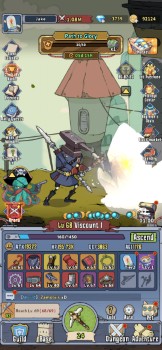 |
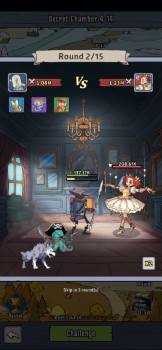 |
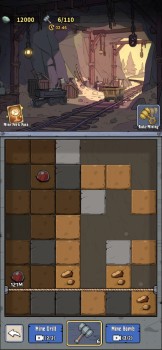 |
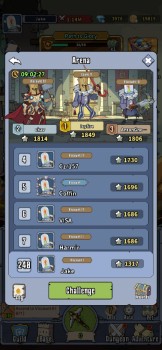 |
| Collectables | Events | Pets | Inventory |
|---|---|---|---|
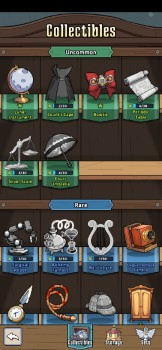 |
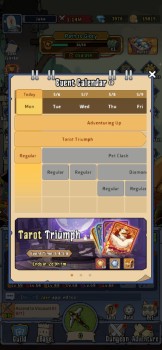 |
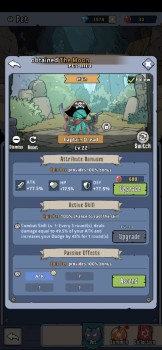 |
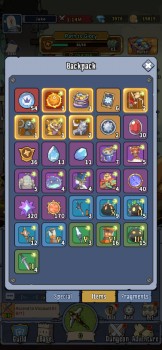 |
Review
In Dig-Dig Rush, you are mining rocks across various areas to “prove yourself” to a big… lightbulb… king? I don’t know, there’s a lot to keep track of in this game and the hint of story isn’t important. Mine the rock, obtain items to make you stronger, kill enemies, and repeat. Simple! Except, there’s so many systems layered on top that is almost feels like a parody of incrementals / gachas, with every “pass” / “arena” / “guild” / “bonus” you can imagine existing somewhere.
So, as I mentioned, Dig-Dig Rush has a truly absurd number of systems and sub-systems. Unlike most incrementals where you are deciding how best to use your resources, here you are merely trying to keep up with the flood of items being thrown at you from progression systems, and trying to work out what on earth anything even is. There are so many that there’s even a progression system for how many progression systems / game features you’ve unlocked, with 24 entries(!).
I’m going to do my best to describe the sources of items / currency I am aware of, but note that I’m only a couple of days in, and have undoubtedly missed some despite staring at the game whilst writing this. Note that most of these reward items of some kind:
- The main game: Mining for items, each with stats & perks, to fit into your 12(!) equipment slots.
- “Climb the Ranks: Adventuring up & Tarot Triumph”: 2x boards of challenges for completing “adventures”, along with end-of-event rewards depending on your rank, and a shop for each. These also earn currencies for the “Ranking store”.
- “Preview”: Diamonds rewarded for unlocking new game features, and showing you what is next.
- “Daily Quests”: Nice and simple quests, reward a unique currency for completion plus rewards at various totals.
- “Week of Wonders”: Totally different system that functions similarly to “Daily Quests”, but you can complete tasks from any current or previous days this week. Also rewards a unique currency.
- “7-Day Sign-in”: Unrelated to the week of wonders, a thankfully simple daily bonus with streak rewards etc.
- Advertising collection of systems:
- “Privilege Centre: Perk Pass”: Mostly just adverts for 4 complex pass systems, but also has a daily bonus.
- “Privilege Centre: Growth Plan”: 5x progression systems for various aspects of the game, with rewards at various levels and the ability to pay for better rewards. Also a daily bonus.
- “Beginner’s Deals”: Standard bundle adverts, yet has a daily bonus.
- “Black Market”: A traditional “exchange diamonds for items” shop.
- “Spending Bonus”: A progression system for total purchases and purchase streaks.
- “Arena”: Player vs player, with loot from each fight and daily & weekly rewards based on your overall ranking.
- “Idle Rewards”: A typical idle system, earning pickaxe uses & coins & time skips over time.
- “Ascension”: Completing large objectives to ascend to a new rank, increasing your stats and level cap.
- “Lode level”: Spending gold to upgrade your chance of achieving rarer loot.
- Character collection of systems:
- Can forge different headpieces with different stats.
- Can upgrade your headpiece to boost stats.
- Can collect sets of headpieces to unlock bonuses.
- Divination collection of systems:
- Can “divine” fragments of cards, that then form full cards, providing boosts.
- Can collect sets of cards to unlock bonuses.
- Pet collection of systems:
- Can summon pets with different rarities and bonuses.
- Can upgrade / merge pets to improve their stats.
- Can collect sets of pets to unlock bonuses.
- Guild collection of systems (there’s also a store):
- Guild trials, fighting a boss on cooldown for rewards, can also claim “chests” when others kill.
- Donating diamonds to the guild in exchange for 3 other currencies.
- “Help”ing guildmates provided coin boosts for both.
- Base collection of systems:
- Mining for stones and other resources in your basement.
- Using stones to purchase various boosts on a tech tree.
- Opening chests with item fragments inside, providing boosts.
- Earning points from these chests that open other chests.
- Collecting sets of collectibles that, you guessed it, provide boosts.
- Adventure collection of systems:
- Fighting steadily harder battles to progress, earning loot after each.
- Receiving rewards for each “chapter” cleared.
- Dungeon collection of systems:
- “Daily dungeons”: 4x unique boss fights, each of which use their own key to unlock and provide unique rewards.
- “Endless trials”: Progressively harder battles, offering chests and other rewards.
- “Challenge the intruders”: Again, progressively harder battles with rewards.
- The 5 systems I haven’t unlocked yet (Farm, Space Odyssey, Backgear, Radio, Artifacts), each of which sound large.
Are you getting the idea now? It’s ridiculous, and you’ll be spending all your time just trying to wander around the menus and find out where to claim whatever free item you have there. It seems like the game’s strategy is to include every engagement & monetisation technique possible, so at least one of them catches you. Like rolling for pets, and upgrading them? Or talking to your guild? Or daily passes? It’ll be in here somewhere!
There also seems to be multiple servers you can play on at once, with a new character in each. Just yet another feature.
Eventually your pickaxe uses start to run out, but I hit ~1m power before then, and I’m pretty sure when I wake up tomorrow I’ll have a thousand free things to sort out. The game’s art is beautiful, and there are hundreds of unique assets, yet it’s hard to actually notice them in amongst all the stuff on screen at any time. It’s not unusual to have 3-4 dialogs stacked on top of each other, each requiring an action, as you try to navigate a menu whilst auto-mining in the background.
Bizarrely, despite the game having more features than almost any I’ve played, it only has ~50k downloads, and their Discord only has ~400 members! The game feels like it’s a massively popular AAA game from an alternate universe that has just been transferred in, and has lost the millions of users that are surely needed to build something so complex. I did notice some non-English very briefly appearing at one point, and the developers are in Singapore, so I wonder if this is a giant game in China / elsewhere now entering the western market.
It’s hard to review this game beyond saying that if you enjoy drowning in menus whilst watching numbers go up, you’ll enjoy it. I do, I think. It’s hard to tell.
Monetisation
Think of a technique, it has it, at every price point from $1 to $300. Truly absurd:
- Ads to skip waits, ads to retry fights, ads to increase rewards, ads to roll for rewards.
- Bundles of different currencies, bundles for starters, bundle for specific use cases, bundles of items.
- New starter bonus, limited time bonus, first purchase bonus, purchase streak bonus, increase rewards from various passes bonuses.
- Pay to spin the wheel, pay to upgrade rewards, pay to skip waits, pay to get daily rewards, pay to remove ads, pay to beat other guilds.
Despite this madness, there’s so much going on that it all kind of cancels out. I usually buy 1-2 things in a game, but there are so many options here that none of them stand out. The closest thing is the “Monthly pass” providing daily stuff for ~$6, yet so much is provided for free anyway that it feels pointless.
Truly impressive how the game has been overmonetized to the extent that I’m unlikely to spend anything or watch any adverts!
Tips
- Complete quests as soon as they appear, to unlock the next one.
- Focus on the ascension goals, they’re what actually matters long term.
- Save your pet summon points for one good pet instead of upgrading your starter.
- The global chat can be absolutely awful, but keep an eye out for a good guild to join.
- Good luck finding all your various things that are recharging on a timer, I constantly find new bits and pieces!
- As you level up(?) you can auto-pickaxe more at once, there’s no downside to always setting this to your maximum.
- There is a Discord.
#3: Paper War
Paper War is a straightforward autobattler, where you’ll be building up a little army to fight enemy armies and complete quests, earning coins and gems to upgrade your army. And repeat.
Screenshots
All screenshots are from version 24:
| Combat | Skills | Army |
|---|---|---|
 |
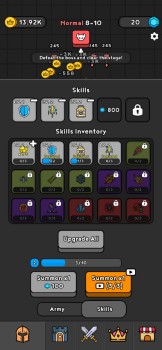 |
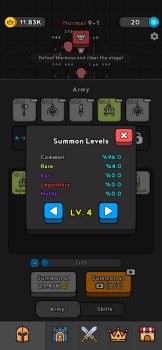 |
Review
Before diving deeper into the review, this game is a bit odd. It has a solid early game, and looks like it continues to grow, but in reality you’ve seen pretty much all of the game’s content after 10-20 minutes!
The developer seems to have 2 other quite similar games (same concept, style, UI), Circle Defense and The Army, suggesting to me at least that perhaps each game isn’t a labour of love, but instead trying to figure out what will get users / profit.
So, with that massive caveat out of the way, what is Paper War? Well, you’ll recruit permanent “Characters” to your army, and summon permanent “Skills”, which will then automatically attack waves of enemies for you, with no ability to take manual control. There’s essentially no strategy around placement, and all skills autocast perfectly, with the only real choice being which skills to select and what to spend earnings on.
The game isn’t balanced, with my single rare “Onager” being 10x as strong as any other character in every aspect. As characters do not respawn between waves, this means only my rare character survives any battles for more than a second, so is typically all I’ll see! Whilst there is a “Gold Rush” and “Boss Rush” mode (requiring slowly respawning keys), the enemies will die so quickly they’ll barely be visible, making it really just a “free loot” mode.
There is a quest system helping to guide your initial gameplay, but it quickly hits an impassable wall. Upgrade costs increases as you upgrade, so getting from 100 -> 150 in a skill is about as tricky as, say, 150 -> 170. As such, quest 84 that requires getting from 200 to 700 hitpoints is essentially impossible unless you leave the game alone for hours, and your progress is severely limited until it is completed (quests are the main gem source). You can also prestige, but it provides negligible benefits (20% more gold) in exchange for an almost complete reset!
Finally, there’s a PvP event (which required signing up for an account) that is very bare bones. Use a ticket, get matched randomly against an opponent (AI, using a player’s army), one of you completely destroys the other. No tactics, no planning, just matching against someone with literally 1000x stronger units than you. A bit pointless.
So is it good? Well, no not really. Every minute playing it is vaguely enjoyable, and it looks pretty, but you’ll notice essentially no difference 10 minutes vs 100 minutes into the game, with other player’s reviews suggesting this isn’t going to change any time soon. Perhaps one to pick up for an hour, then delete.
Monetisation
This is probably the most fleshed-out area of the game! There are 4x “cards” providing various daily bonuses, 3x “packages” providing resources, 6x gem packs, and various incentivised ad offers scattered all over the place.
None if it is forced, but I do suspect the slowing down of gameplay is to encourage paying.
Tips
- A single strong unit will overwhelm everything else, so you might as well use all your summoned army units to upgrade your strong unit / maximises chances of getting one.
- Try out the skills, I found “Poison Cloud” (area of effect attack) to work well.
- There is an oddly large Discord.